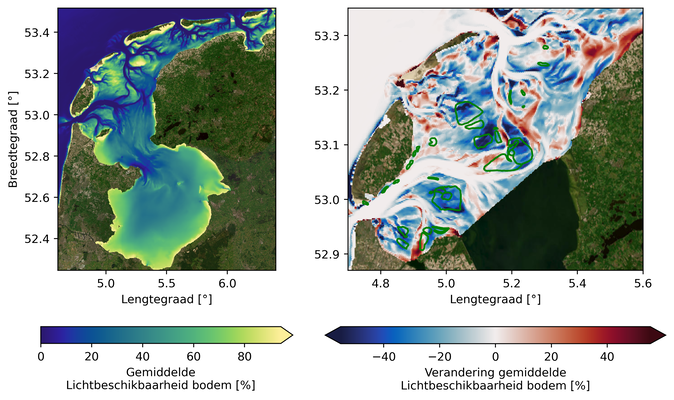L. Jaksic1*, B. Smits1 , J. Dijkstra1, J. Vroom1, O. Franken2,3, K. Rehlmeyer2, J. de Vries4, R. Cammenga5, E. Lofvers5
1 Deltares, The Netherlands; 2 Rijksuniversiteit Groningen, The Netherlands; 3 NIOZ Royal Netherlands Institute for Sea Research, The Netherlands; 4 Rijkswaterstaat WVL, The Netherlands; 5 Rijkswaterstaat NN, The Netherlands
* Corresponding author: Luka.Jaksic@deltares.nl
Introduction
Large portions of the North Atlantic seagrass populations disappeared in the 1930s due to the outbreak of the 'Wasting Disease’. The disappearance of Eelgrass (Zostera marina) in the Dutch Wadden Sea coincided with the construction of a mayor closure dam [Afsluitdijk] which largely affected the abiotic conditions in this basin. Today, the recovery of Eelgrass is a goal in the Water Framework Directive and Natura2000. While intertidal Eelgrass shows signs of recovery resulting from restoration experiments and improved water quality (Van Katwijk, 2002), efforts to reintroduce the subtidal variety remain unsuccessful. The Waddenmozaïek project investigates the recovery potential of subtidal Eelgrass by measuring abiotic conditions, combining these with habitat suitability relationships from literature, and testing bottlenecks of abiotic conditions (Rehlmeyer et al., submitted). In this study, we expand on the existing field measurements and literature-based tolerance limits by re-creating the historical, Wadden Sea-specific, abiotic conditions relevant for Eelgrass growth in a numerical model. The hypothesis investigated here is that the closure of the Zuiderzee in the 1930s created long-term unfavourable abiotic conditions for Eelgrass growth, impeding its recovery to date. This study was set up within the research program BenO Waddenzee, with funding of the Water Framework Directive.
Objective and Methods
Numerical model simulations were employed to study the effect of the Zuiderzee closure on the abiotic conditions that could affect Eelgrass growth, such as light availability and salinity. To study both the direct effects and long-term morphological effects of the Zuiderzee closure, the existing 3D Dutch Wadden Sea model (Vroom et al., 2020) was adjusted to reflect the situation before and directly after the closure of the Zuiderzee, specifically including the effects of the then present meadows on water motion. This modified model setup was validated using historical water level data (quantitatively); and using bed sediment composition, salinity, and flow pattern maps from literature (qualitatively). Finally, habitat suitability maps were made based on the model results to investigate what areas in the present-day Wadden Sea are most promising for Eelgrass recovery.
Results
Our findings suggest that in the years following the closure of the Zuiderzee, some of the sites where subtidal Eelgrass once grew had temporarily become intertidal – and thus unsuitable for the recovery of subtidal Eelgrass. Our model results indicate that the other abiotic conditions for Eelgrass growth have generally deteriorated in the western Wadden Sea, particularly on the flats that once hosted the meadows. Reduced light availability, largely attributed to increased turbidity, plays an important part in this. The model results indicate an increase in turbidity due to the closure of the Zuiderzee, resulting in less favourable conditions in the present-day Wadden Sea. Our preliminary habitat suitability results based on model data, can help researchers and nature managers to indicate potentially suitable locations for Eelgrass restoration.

The near-bed light availability (% of the surface radiation) in 1927 (left) and the change between 1927 and 2017 (right). The light availability is based on spring-neap averaged model results during the growing season. Green contours indicate the locations of the former Eelgrass (Zostera marina) meadows.
References
Van Katwijk, M.M.; Van Pelt, S.; Dankers, N. (2002). Herintroductie van Groot zeegras in de westelijke Waddenzee (2002-2006). Inventarisatie van bestaande kennis, selectie van locaties en plan van aanpak. Katholieke Universiteit Nijmegen & Alterra. Rapport WeL0731.
Rehlmeyer, K.; Franken, O.; van der Heide, T.; Holthuijsen, S.J.; Meijer, K.J.; Olff, H.; Didderen, K.; Lengkeek, W.; Govers, L.L. (submitted). Reintroduction of self-facilitating feedbacks could advance subtidal eelgrass (Zostera marina) restoration in the Dutch Wadden Sea.
Vroom, J.; Van Weerdenburg, R.; Smits, B.; Herman, P. (2020). Modellering slibdynamiek voor de Waddenzee Kalibratie voor KRW slib. Deltares rapport 1205229-001-ZKS-0001.


